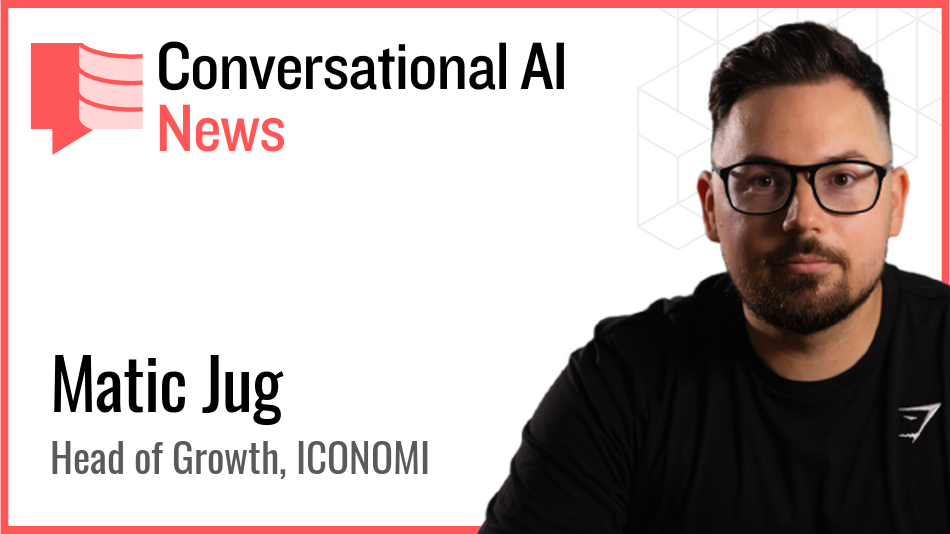Help: "My manager is skeptical about the practical benefits of Conversational AI"

Here's a question that was submitted to Squirro's Conversational AI Webinar that took place this afternoon via Zoom.
Due to the packed agenda, we didn't get a chance to directly address this particular one so I resolved (with the approval of Squirro) to answer this one later on.
Here is the question that was submitted:
"My manager is skeptical about the practical benefits [of Conversational AI] - what arguments can I bring to convince him?"
Let me answer this question with the following points (plus I've added a section below this for vendors to consider.)
Proof Point 1
So, your manager is skeptical about the practical benefits of Conversational AI.
Here's the one go-to metric I use, almost daily, in meetings with senior executives:
There's a financial services firm I know that's redeployed two call centres worth of people (600-700 FTE) as a direct result of their Conversational AI chatbot taking over the call centre the load.
End customer satisfaction is up 200%+, employee satisfaction has tripled and sale revenues up roughly 7% year-on-year - directly attributable to the chatbot.
(Note: These above figures are indicative, but not accurate. Even though I haven't identified the client, I can't give precise figures due to confidentiality agreements. So these are 'made up' but in the general ballpark.)
I usually pause there to let the client think on the topic.
Every senior executive is automatically doing this calculation in their head:
- 700 FTE at a base salary cost of $45,000 per year employee (or whatever the average salary amounts are) = This is $31.5M. This, dear reader, is a material figure for anyone in financial services and beyond.
The executive is then – within milliseconds – going to revise this figure upwards by calculating the fully loaded cost. They usually have this roughly to hand in their minds:
- 700 FTE at a fully loaded cost of $115,000 per year, per employee = $80.5M.
There are all sorts of further points to discuss. But these are 'round figures'. This is how many senior executives are thinking in terms of costs.
Now, not once have I mentioned savings.
In this example, I'm not necessarily suggesting that the client fired 700 people. In many cases I've seen, the opposite happened. You see, when you go to a senior executive and say, would you:
- a) Like to remove 700 people and save something like $80-odd Million of fully loaded cost?
- b) 'Hire' 700 new people at a cost of $80M+ to focus on generating additional high value revenues? (Note, these 700 people are are currently a sunk cost supporting your existing level customer demand.)
Some executives will be tempted by the immediate cost savings. Most will go for option B though. The market has already baked in the cost of these people, so if you can use them to generate even more revenues by focusing on high value conversations, fantastic.
So that's one 'proof point' for the manager.
Here are some more activities to consider:
Our competitors are doing it already
This is going to need a bit of leg work – you'll need to go and do a lot of research. It's often highly inappropriate to go and speak directly to your competitors so consider reaching out to the Big 4, or talk to your company's own "technology partner" - think IBM or similar. Ask your colleagues what your competitors are doing with Conversational AI. They'll often have a 'public' answer that they can share with you.
Our competitors are looking strongly at this space
I like to publish job ads here on Conversational AI News to show what's moving in the marketplace. Sometimes you get some fabulous nuggets hidden inside the job specification. For example, there's a Tier-1 bank hiring for a Conversational AI Product Owner at the moment - in the text it says words to the effect of "we firmly expect Conversational AI to be the #2 medium for customer engagement by 2025.
So being able to evidence to your manager that your competitors are actively looking at the space, even if they haven't launched anything, is valuable insight – and potentially likely to get your manager to start reassessing their position.
Similar companies in different industries are doing this
See if you can find some case studies indicating how other comparable companies are managing Conversational AI. So, if you work in a bank, perhaps you could look at what some Insurance companies are doing. If they're non-competitive, you could even reach out to some peers and get their perspectives.
Our peers in another country are doing this
Most big established companies have peer companies in different geographies that they informally engage with. Most banks, for example, will often have informal relationships with other peers in other countries – to exchange ideas and experiences on a non-competitive basis. If your company has something like this, see if you can leverage existing relationships to reach out and discuss their approaches and views of Conversational AI.
Talk to the Big Consultancies & Implementers
The chances are, your company retains one of the big consultancies. McKinsey. Bain. BCG. PWC. PA. KPMG. In many of the banks I've worked in, the partner will often have a security pass for your headquarters! These partners routinely meet with senior executives – often once a quarter. Their job is to listen to any challenges or questions you might have – because your simple enquiry might end up in a multi-million dollar service commitment. This is how they win business. So the partner(s), directors, etc. will be only too happy to listen to you – and see if they can help.
It's not unheard of for such consultancy firms to go and do some informal research for you, then put together a briefing pack for you... free of charge, on the basis you take it to your manager. Or you invite them in to discuss their findings with you and your manager. Note: Make sure you clear the politics first – talk to your manager before doing anything here. It can get unnecessarily political very quickly, especially if the CEO is not a fan of the consultancies!
Internal vs External
Don't forget this point in your research: A LOT of companies have already done a huge amount of work with Conversational AI internally. This week alone I've spoken to at least 5 massive FTSE/Fortune 200 companies that are doing absolutely nothing with Conversational AI externally. But they ALL had internal programmes at various stages of implementation. So don't forget to ask friends and colleagues about internal implementations too. Sometimes the proof-of-value that your manger might be seeking can be demonstrated, really quickly, internally.
Just as an example, there's one chap I was speaking to this week who was telling me about how their company has essentially replaced their internal helpdesk with a super-effective, highly capable Conversational AI. It does everything. Installs software you're missing. Sorts new permissions. Orders new equipment. Talks to third-line support on your behalf if necessary, etc.
Arrange a Roundtable
If your manager is open to discussion, you might contact some Conversational AI vendors and explain this. You could consider to suggest that the vendor arranges an informal roundtable over a meal with your manager and a few other clients (in non-competitive industries if necessary). This could be a highly valuable way of helping the manager understand examples of what other companies are doing – and has the added advantage that they do the learning themselves rather than you telling them.
Arrange a Beauty Parade
One thing I do regularly with clients is arrange 'beauty parades' on behalf of companies who are looking at Conversational AI but perhaps aren't quite ready to do anything – or, who don't yet know where to begin.
As long as it's properly managed, bringing in a series of vendors across a week or across an afternoon can be highly instructive, especially if you ask the vendor business development teams to focus on case studies and outcomes that they've seen their clients achieve.
One of the services I offer is to sit with each of the vendors, explain the client's situation and then brief the vendors to prepare a specific approach. Yes, introduce yourself, but get to the outcome and value topics very quickly. I also carefully explain to the vendor that this is not an RFP, that there is NO RFP yet, that it's simply a relationship building opportunity for the client to learn more. Of course, if the vendor does a good job, these sorts of meetings can be highly valuable for all parties.
Ok.
Let me stop there.
If I can help with any suggestions or ideas, please do drop me a note. Likewise, if you have some ideas on how you would answer such a query, I would encourage you to comment below or write your own posts. I'll certainly update this post with links.
[Update: David Hannibal, Chief Product Officer at Squirro penned his thoughts here on LinkedIn.]
My Message For Conversational AI Vendors
I would like to encourage all vendors to think carefully about the question posed above and the context surrounding it.
For clarity, here it is again:

What are you doing to support and enable individuals such as the person who submitted this question?
All too often, vendors are next to useless when it comes to helping answer such basic issues. Conversational AI is on the lips of many. Even if it looks like a target customer is doing nothing – and even if executives maintain they're 'not doing much', the chances are, someone in the organisation is already looking at the possibility of deploying Conversational AI.
So what are you doing to help?
How are you helping them?
The answer, dear reader – dear vendor – is not to try and book and meeting and SELL, SELL, SELL the senior executive or the 'manager' mentioned above.
No. Geez, no.
The answer is to inform and educate.
Offer as much practical, useful information as possible to the marketplace – and to individuals such as this.
The problem isn't that the 'manager' doesn't know about your product.
That's NOT the problem.
The challenge is that the manager has already decided Conversational AI isn't something they or the company wants to look at.
They've been there, got the t-shit and the current strategy is: No.
Perhaps the manager was burnt in the past. Perhaps the manager is misunderstanding the term 'Conversational AI' or simply thinks it's a glorified decision-tree chatbot.
The problem is not your vendor offering: The problem is your industry.
The manager doesn't buy it, for whatever reason.
This why ever vendor has a responsibility to inform and educate, especially now – today, this year and next.
It's a question of value
Your customers are getting value from your Conversational AI service offerings, right?
Of course they are: Every week I come across dozens of magnificent examples of cost savings, efficiency gains, productivity delights and so on – all being driven by fantastic Conversational AI vendors.
One of the issues: Your customers aren't generally talking about the great work they're doing, or the achievements they're making.
They don't do this naturally. This isn't the customer's job. By all means, some announcements might make it into the quarterly or annual reports to show off their achievements – but, generally speaking, customers of Conversational AI aren't out there selling the benefits of the technology. Why should they?
This is why I am constantly staggered when I am consulting with clients already using Conversational AI. Some of the results are utterly astonishing – and they're already at huge scale. The results are what we in the financial industry would define as 'material' – i.e. flipping brilliant!
In most cases, these results are confidential. Many companies I'm working with are perfectly happy for the rest of the market to sit in total ignorance – just like the 'manager' referenced above. You want your competitors sitting in the corner wondering why you're delivering phenomenal results!
So there is a strong tension here. I have often been the executive – or part of the executive committee - where we have actively decided not to disclose the phenomenal results we've been achieving from various technology decisions for this precise reason.
At the same time, there is a need to take a victory lap, often at the quarterly or annual results stage.
Another technique I've used (and often suggested to CEOs who also don't want the market to know just how good we're doing!) is to release last year's figures. For example, "in 2022, we had processed 5 million conversations automatically to a 70% accuracy". When the actual figures, today, might be triple. Keep the competitors guessing.
The best possible result for vendors, of course, is where a client is perfectly happy to share some high level metrics (or, even better, detailed outcomes). It's possible to encourage this – especially if you suggest using outdated information that indicates great results.
What to do? Well, here are some ideas:
- Get your client senior executives on your podcast (and other podcasts) to discuss their Conversational AI journey. Feel free to write to me and I'll invite them on to our Conversational AI Podcast to discuss their journey. That almost always involves the need to give some kind of metrics to explain and illustrate the outcomes.
- Host a roundtable event and invite your clients to meet each other and discuss their Conversational AI journey in a 'private' session. Also invite your prospects along to learn what's happening. We regularly run roundtable events here - drop me a note and let me help you with this.
- Host a webinar with your clients to discuss their Conversational AI journey – this is often viewed as a bit too commercial by some clients ("What, you want me to sell your services for you??") – but I would encourage you to at least try to suggest this. Some clients will be keen to participate.
- Invite your clients to an industry conference to talk about their Conversational AI journey. Most event organisers will be delighted to feature end-users such as your clients talking about their Conversational AI journey. You might consider to help support the event organiser with some sponsorship to help facilitate this. I should also point out that I can help with this through our Conversational AI Summits. Make sure you write up what the client says publicly.
- Write a case study for your clients. You might need to do this anonymously, in order to get approval to publish publicly. But it's worthwhile writing a case study that you plan on using internally anyway – but send it to the client and ask them if they'd allow you to use it publicly.
- Ask your clients to do a video podcast. Show up with a full video production team at the client's office and make them look fantastic as they describe their Conversational AI journey.
- Write a book about your client Conversational AI journeys. You might think I'm nuts, but many client executives will react positively if you explain that you're writing a book that you're going to publish on Amazon shortly. Ask the client executive to be a co-author, so they'll get their name in Amazon. Ask the client executive to meet you on a Zoom call and to talk for 60 minutes about their experiences with Conversational AI. Write this up into a chapter. Let the client's PR team edit it as much as they wish. Now you've got a comprehensive case study. Stick 10 of those together into a book and publish. Let me know if you need help by the way - I can help do that for you (Contact me).
- Create a case study section on your website and give someone the task of publishing 2, every month. Written or video or both. Some vendors already do this.
- Communicate widely: If you don't already, make sure you publish any public material widely and regularly across your website, newsletters and social channels.
Thanks for reading!
If you've any comments, please go ahead and add them below.
(You need to register - it's free to post a comment. Use the 'subscribe' button top right.)




